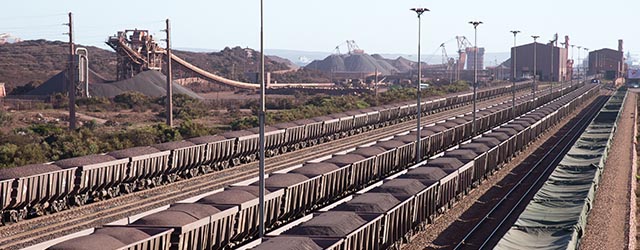With each country responding differently to the commodities crash, Africa showcases a range of mitigating efforts, with varying success.

African countries raked in unprecedented, large sums in revenue from the booms in commodity exports in the 1970s as prices surged globally. With these, many governments in the region embarked on grandiose programmes that lacked relevance to the true conditions of their economies. Then commodity prices tanked in the early 1980s, and since that time the boom-bust cycle in their earnings has continued.
Yet many of them failed to see these crises, including the commodity price collapse in 2009, as opportunities to take proactive steps to strengthen their economies. Only a few countries recognized them as such. The ones that responded and prepared by diversifying their economies have walked into a more secure future. Others plodded on, unmindful of the dangers ahead, and are today, in the current commodity sell-off, worse off for it.
From aluminium to gold, copper, cocoa, coal, and oil, prices of commodities have experienced fluctuations on the global markets, making African producers temporarily rich, but the effects have not been uniform across the continent. Some commodities have more economic impact than others.
“Africa is not homogenous,” says Stuart Culverhouse, global head of research at London-based Exotix Partners. “While many countries are commodity exporters, some are oil importers and should benefit from lower oil prices, or have more diversified export bases so that they do not depend so much on a single product.’’
Those that do rely heavily on a single export—such as the continent’s leading oil producers, Nigeria and Angola—are highly vulnerable. State revenue has fallen by as much as 50% in Nigeria, which is currently making efforts to diversify into solid minerals, agriculture and other such products for export.
And too much reliance on exports is itself a problem. “The situation is made even worse [when] the local people do not much consume the commodity which they produce for exports,” says Joseph Amamoo, a Ghanaian lawyer and author of a newly published book, Africa: Rich but Poor, explaining that if Europeans and Americans stop eating chocolate, for example, cocoa-producing countries suffer from lack of any local market. “Africa is rich but poor because we have not learnt to exploit by ourselves our vast natural and mineral resources or learnt how to manage them.’’ Amamoo believes the solution is to diversify local economies.
THE BENEFITS OF DIVERSITY
Diversification is the reason for the sterling performance of some countries, such as Rwanda, Uganda, Tunisia and Morocco, says Kayode Tinuoye, head of research at Lagos, Nigeria-based United Capital Research, a part of United Bank for Africa Plc.
“As far as diversification is concerned I think most of these countries have over the years played to their strengths,” he says. The African continent has a comparative advantage in agriculture with abundant land and labour resource, and he believes this is where countries like Morocco and Rwanda have gotten it right over the years.

However, it is not enough to diversify into agriculture. Tinuoye points out that while most countries in the west Africa region have a substantial agriculture base, accounting for between 10%-20% of GDP, depending on the country, the sector is not a major revenue earner in most cases. In 2014, Nigeria rebased its economy and the government announced that the services sector’s share of GDP had risen to 51% from 26% previously. Also, agriculture fell to 22% from 33%, while oil and gas accounted for just 15%. Despite this realignment, oil continues to account for about 70% of government revenue and about 90% of foreign exchange earnings.
“The productive base of the economy may be diversified, as in Nigeria where we have seen a very large services sector,” Tinuoye says, “but if government revenue is still skewed to commodity prices, the pressure will continue to be felt.” Morocco, for example, is talking about diversifying its economy away from agriculture in order to encourage other sectors of the economy, like manufacturing and energy.
For Morocco and Rwanda, net oil importers, the falling price of that commodity has benefits. Rwanda was able to maintain GDP growth rates of close to 7% in 2014 and 2015. GDP in Morocco leapfrogged from 2.4% in 2014 to 4.7% in the following year. Of course other factors are at play, Tinuoye notes: “The impact on inflation in these countries has not been significant due to varying domestic issues, ranging from infrastructure and fluctuations in agriculture output due to natural factors, to the impact of exchange rate pressure on imported inflation.”
CURRENCY PITFALLS
The secondary impact of tumbling commodity prices on currency devaluations can’t be ignored, and governments have responded to varying degrees. Angola devalued its currency and tightened fiscal policy. Currencies have been stable in Zambia and Ghana in recent months, after previous sharp falls, probably after official intervention, while currencies in East Africa (Uganda and Kenya) have been fairly stable too, according to Culverhouse.
In Nigeria, on the other hand, where foreign reserves fell to $27.7 billion in 2016 from $38.6 billion in 2014 according to the Central Bank of Nigeria, the government has ruled out a devaluation of the naira, its currency, insisting this will hurt the import-dependent economy. Instead, the central bank announced various restrictions, including banning credit card payments in foreign currencies as well as foreign exchange at the official rate (197 per dollar, compared to as much as 320 in the black market) for importation of a list of 41 items, including toothpicks. “Nigeria,” Culverhouse notes, “has not really adjusted at all.
The restrictions have so far failed to curb pressure on the naira, and in January, IMF Managing Director Christine Lagarde chastised the government over its currency management. “Additional exchange rate flexibility—both up or down—can help soften the impact of external shocks,” she counseled. “It can also help avoid the need for costly foreign exchange restrictions—which should, in any case, remain temporary.”
Tinuoye describes Nigeria’s long dependence on oil as “unfortunate,” but perhaps not an insurmountable problem. “Frankly, the poor management of oil revenue over time is even more telling,” he says. “When you smooth out the trend over the last four decades, you come to realise that the economy could be doing a lot better today with slightly better and more accountable bookkeeping in those periods of oil prices in excess of $100 per barrel.”
Culverhouse likewise recommends sound policies and saving during good times to hedge against fluctuations. He attributes the successes recorded by Tanzania and Ethiopia to their more statist development plans. Because they are also relatively closed to outside investors, he says, “perhaps they are less exposed to fragile investor sentiment and capital outflows compared to countries that are more integrated with the global economy, like Nigeria, Ghana and Zambia, and as a result have not been as badly affected.”
Ivory Coast, the world’s biggest producer of cocoa, has been doing well despite a troubled history, according to Culverhouse. Under President Alassane Ouattara, Cote d’Ivoire, as it is also called, has performed strongly through “the pursuit of sound macro policies and structural reforms, and developing the private sector and encouraging foreign investment.” The government restored political stability after political tensions erupted over disputed election results in 2010.
Mozambique emerged from a civil war (1977-1992) to become one of the success stories in Africa. According the World Bank, the country achieved an average annual growth rate of 7.5% for the ten years from 2005. It has attracted investments into its commodities, notably aluminium and coal. In 2015, it was the highest FDI recipient, with $6 billion inflow.
But for Culverhouse, this southern African nation “has not been such a success, as it too suffered last year from balance of payments problems.” A tumbling currency forced the nation to take a $282.9 million loan—and related program of lower spending and higher interest rates—from the IMF in 2015. Culverhouse also points out the government’s handling of the $850 million seven-year EMATUM bond (aka “tuna bond”), which it guaranteed for a fishing company in 2013. Difficulties in repayment forced the government to restructure—unnecessarily, in Culverhouse’s view—a government-guaranteed sovereign bond, which he believes may damage its reputation with foreign investors.
Still, the nation has options. “Medium-term prospects look promising if the country can successfully develop its vast offshore gas reserves,” Culverhouse notes, but adds that this will make its economy less diverse over time. Anadarko Petroleum of the US and Italy’s ENI are currently working to jointly develop the gas fields for export.
Amamoo says that going forward, the continent and its peoples will have to engage in productive joint ventures with investors from both the West and the emerging economies of Brazil, China and India, to fully harness the abundant resources of the region. That’s still a hard sell.
PAVING THE WAY FOR FDI
Despite the known opportunities identified in Africa, in terms of global investment flows the region continues to be a fringe player. According to UNCTAD World Investment Report 2015, global FDI inflows fell by 16% overall in 2014 to $1.23 trillion, from $1.47 trillion in 2013. Africa’s share of this global figure is quite low—less than 5%. For the three years 2012, 2013 and 2014, Africa’s share of FDI was 4% ($56 billion), 3.7% ($54 billion) and 4.4% ($54 billion), respectively.
Amamoo’s advocacy of joint venture as the way out for Africa is indeed pertinent. Some of the progress being made across the continent is traceable to such strategic ventures. These projects are operating in diverse sectors, including oil and gas, power generation and distribution, agriculture, agro-processing, and financial services.
He says that Africa is currently not in the position to maximise all its natural and mineral resources due to lack of managerial skills, experience, finance and lack of infrastructure. “The solution is to enter into joint ventures with sovereign or corporate investors from the developed countries, and India, China and Brazil,” he says. Amamoo believes African governments should pursue a robust program of encouraging foreign investments from the west, India and China, to reduce unemployment, especially among the youth, and generally improve the quality of life of the local people.
Equally vital is for the governments in Africa to build the infrastructure – for example roads, hospitals, provision of clean water, and public sanitation. In addition to improving the quality of life of the populace, such improvements would enhance productivity and entice foreign investors. “For you cannot get much,” Amamoo notes, “from a work force that is frequently sick from malaria, typhoid fever, malnutrition and other easily preventable medical conditions.’’



